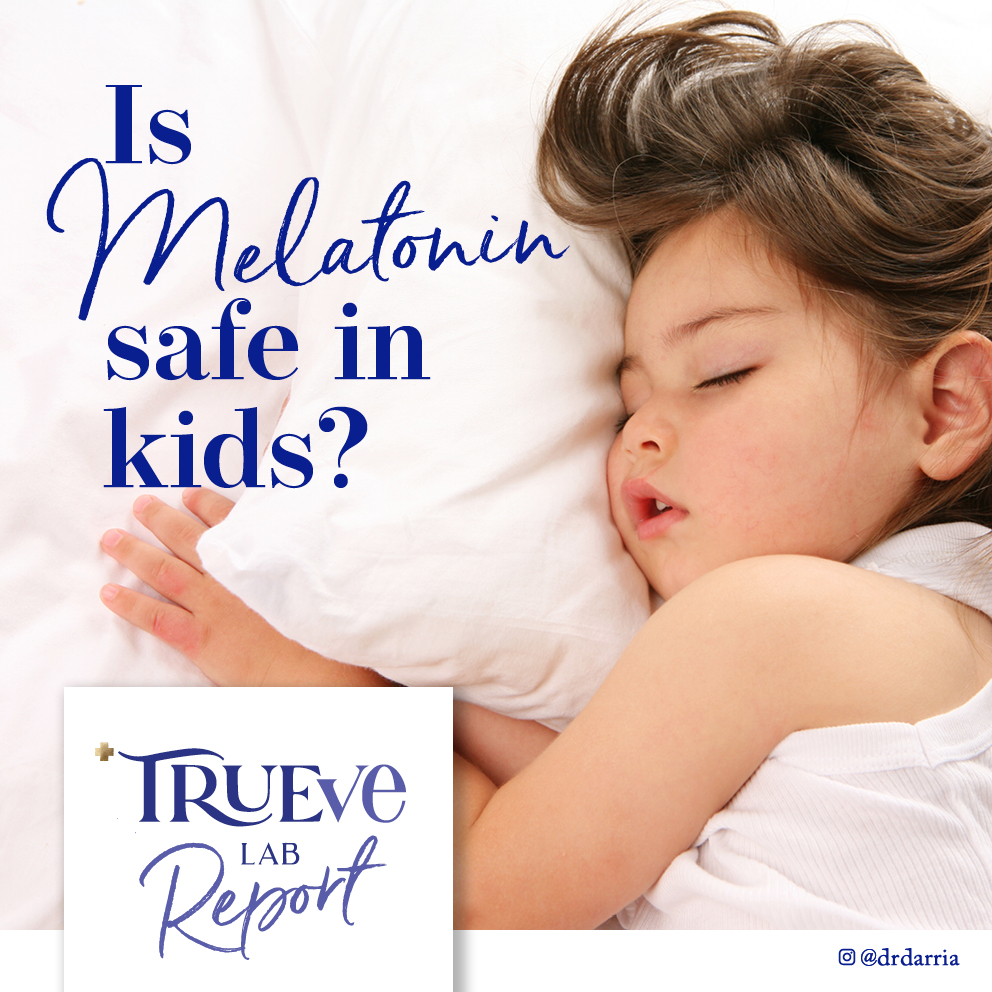It’s 9pm and your toddler’s running around naked. Are those melatonin gummies your BFF mentioned safe? Do they work?
You’re not the only parent asking. Sales of melatonin jumped 150% from 2016 to 2020.
BUT, consider this: over-the-counter melatonin is banned in the UK, EU, and Japan. While that’s not always the best barometer, it should at least cause us to review the data. Do these countries know something that we don’t?
Also, the latest CDC MMWR showed that in 2020, melatonin became the most frequent cause of calls to Poison Control for children ingesting it. That pushed us to publish this Truevelab Report ASAP (it was originally scheduled for later this summer).
Summary (TL;DR version)
Read this before giving your child melatonin.
- Melatonin requires a prescription in the EU, UK, and Japan (Unlike the US, where it’s available OTC and not regulated).
- Melatonin Safety Concerns in Kids
- Labels are inaccurate. Bottles have been shown to have labeling dosage off by as much as 465%; 26% of melatonin bottles in one study actually contained serotonin.
- Melatonin also impacts on insulin, the immune system, and reproductive hormones
- There are no long-term safety data in neuro-typical children. Studies focus on ADHD, Autism, and visually impaired.
- Melatonin is the #1 reason for calls to the Poison Control Center for children under 5
- Given that, we’d save melatonin for: (details in full report below)
- Jet lag / Sleep Onset Delay: For the very short-term (max 5 days) to help fall asleep =
- For children with specific conditions such as Autism Spectrum Disorder, ADHD, or visual impairment, within the treatment plan of their doctor.
- NOT ok to use melatonin:
- For promoting “better sleep”
- To help your child stay asleep
- What to do instead? Most of us are doing things that disrupt our natural melatonin cycle; taking a supplement doesn’t replicate that cycle, it just gives us a “hit” of melatonin. We’re better off stopping the disruptors in the first place.
Bottom line, given the very real concerns I have about melatonin safety (both from a regulatory standpoint and the possible hormonal effects), the lack of long-term safety data, the fact that it poorly mimics our natural cycle, and the efficacy of lifestyle changes, I don’t recommend long-term (even occasional) melatonin use in normally-developing kids, except for in the two scenarios below (in full report below).
Want more details? Read on for the full report, below. and
WHAT IS MELATONIN?
A hormone: Melatonin is a hormone produced primarily in the pineal gland in the brain, (and also in specific cells in your gut), that acts on other areas of the body.
Think of melatonin like “chemical sunset”: Melatonin has two key effects
- Chronotropic – i.e., controlling your Circadian Rhythm (or “body clock”. As a hormone, melatonin is a messenger – to carry the message of “it’s light – wake up” or “it’s dark – time to rest” from the eyes and brain, to the rest of the body.
- Hypnotic – this means that it also makes you a little sleepy (think like after taking Benadryl), so you can fall asleep. However, it helps you fall asleep; not stay asleep.
A typical melatonin cycle rises 1-2 hours before your typical bedtime, then continues to rise after you fall asleep, peaking about 1 hour later. It stays at that level throughout the night, declining when we wake up.
But just because our body makes it, doesn’t make supplementing it “safe”. Our body manages hormone levels more precisely than your fancy European watch: very specific checks and balances exist in your body, to control its timing, peak, and valleys. Taking melatonin as a supplement bypasses those controls; instead of a natural cycle, you have a rapid peak, then decline.
HOW IS MELATONIN AVAILABLE IN THE US?
Supplementary melatonin is available as a liquid, pill, capsule, or gummy form.
It’s designated by the FDA as a dietary supplement, meaning that there is very little oversight into the safety, efficacy, or testing of claims, and it can be bought over the counter (OTC).
Interestingly, MANY countries ban the sale of melatonin over the counter- and only allow it to be sold as a prescription. That includes the UK, EU, and Japan. That’s why it’s important to also know the difference between the melatonin you may buy on any shelf, and what experts may recommend as “pharmaceutical grade”.
Melatonin poisonings are up in kids
The latest CDC MMWR found that the number of calls to Poison Centers for children ingesting melatonin increased by 530% between 2012 to 2021. In fact, by 2020, melatonin was the single most frequently ingested substance by children, reported to Poison Control Centers.
Outcomes: Of the 260,435 calls over 10 years, 4,000 children were hospitalized, almost 300 ended up in the ICU, and there were two deaths. The biggest source of increased calls were accidental ingestions in children 5 and under.
MELATONIN SUPPLEMENTS AREN’T NECESSARILY SAFE
- Over the counter (OTC) Melatonin is illegal in the UK, EU, Japan, and Canada. For all of the reasons below, melatonin is only available as a prescription in these countries. However, since melatonin is OTC in the US, the FDA does not monitor it for safety, efficacy, nor to validate any claims made.
- Melatonin doses in bottles are mis-labeled. One study showed HUGE variability in what is ON the label, and what’s actually IN the bottle. Scary – especially since they found the biggest misrepresentation exists in smaller doses, such as kids’ melatonin gummies.
- 70% of the bottles had different doses than what the label claimed
- 26% contained serotonin (!!!!!)
- Comparing bottle-to-bottle of the SAME product – some had up to 4 TIMES a HIGHER dose than another bottle with exactly the same label.
- Risks associated with reproductive health / puberty. Melatonin falls with sexual maturation, and studies in animals showed that giving large amounts of melatonin suppressed sexual hormones. This has not been proven in large studies in humans, but it’s enough to give me pause in my own children. Melatonin was also once proposed as a component of birth control (although not on the market), and can interact with birth control hormones.
- Melatonin affects other body systems. Melatonin impacts insulin and blood sugar, as well as the immune system – because each of these are affected by night/day and seasonality, which melatonin signals. That’s why giving melatonin as a pill could have unintended consequences in these areas.
- Melatonin has unpredictable bioavailability. The dose of melatonin that actually makes it into your system is unpredictable, and that’s especially the case when taken orally.
- No long-term safety data in neuro-typical children. The absence of long-term safety data in neuro-typical children is concerning. This review noted that it was “well tolerated” – but in my book (as a doctor and mama), that’s not a sufficient threshold to reach, unless in a situation where there is a clear benefit.
ARE MELATONIN SUPPLEMENTS EFFECTIVE IN KIDS?
- Jet lag or Delayed Sleep-Wake Disorder: The majority of data on safety and efficacy of melatonin in children is in this category of conditions, which essentially happens when your body’s Circadian Rhythm is out of sync with the world around you.
- Sleep Onset Insomnia. The data here focuses on children with Autism, ADHD, or visual impairment. There is no long-term data for children who are developing neuro-typically. One data review (meta-analysis) in children with neuro-disabilities found that total sleep duration typically increased by 30 minutes, but noted that of the 13 studies they included, “all except one were at high or unclear risk of bias”. The authors concluded that the extent of benefit “is uncertain…”, that it is likely greatest in Autism, and, “This finding should be interpreted with caution.”
***It does NOT help for Staying Asleep: Melatonin is NOT helpful for promoting “better, more restful” sleep, nor for helping stay asleep / wakeup later.
BEFORE YOU TAKE MELATONIN, STOP DISRUPTING YOUR BODY’S MELATONIN IN THE FIRST PLACE.
I wrote extensively about this in Mom Hacks (and again here) – I’ve been in to hacking your sleep with light for a while! I’ll also write more in future posts.
Now that you understand how melatonin works, you’ll find that *hacking* (for lack of better word) it naturally works better than a supplement. Read a longer post on this topic here, including no devices and only using lights < 30 watts within 90 minutes of bed, getting bright light as soon as you wake up, and using blue light blocking glasses or software, when you really must be online.
WHEN (AND HOW) TO USE MELATONIN
- Jet lag – Talk with your pediatrician before a trip to get the timing right. Most will advise taking 3-5 hours before the new bedtime, starting on the day you fly out and continuing for up to 3 days.
- Delayed Sleep Onset Insomnia – Do this only while also taking other steps to help your child sleep (see above), and while working with your pediatrician for dosing and timing. They will likely advise melatonin 30-60 minutes prior to bedtime (up to 2 hours before bedtime, depending on the child).
The American Academy of Neurology notes that – when possible – to use “pharmaceutical grade” melatonin.
EXTRA POINTS FROM OUR PEDIATRICIAN ADVISORS ON MELATONIN SAFETY IN CHILDREN
In speaking with Dr. Tanya Altmann, TrueveLab advisor and founder of Calabasas Pediatrics, she stated that she only turns to melatonin after trying all of the other alternatives for sleep hygiene, and even then, usually only for 5 days at max.
Dr. Pip Spandorfer, of North Atlanta Pediatrics, said “in general I try to avoid giving kids medication to help them sleep. However, I do have some patients on ADHD meds who need it every night. Otherwise, I will use melatonin only temporarily when there has been something that disrupted the sleep pattern (like jet lag, recent infection, new sibling). In that case, I try to go with the lowest dose possible, like 0.5 mg for up to 7 days.”
According to Dr. David Hill, pediatrician and TrueveLab advisor, “The key is that with melatonin, less is more. Most people use too much to start, and then when that doesn’t work, they use more. I’ve had kids come in on 20 mg of melatonin which, if it were pure (no guarantee), would be an enormous overdose and not helpful. So start low, like 0.5 mg, 1 mg at the most, and if it’s not working that’s probably because you’re using it wrong. Melatonin is chemical sunset, nothing more. So, give it at least a couple of hours before the target bedtime, and follow all the other rules of sleep hygiene as well. It’s not a Mickey Finn. And, once a new schedule is established, stop it.”









2 thoughts on “Is Melatonin Safe for Kids?”